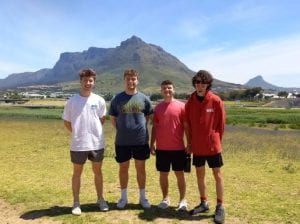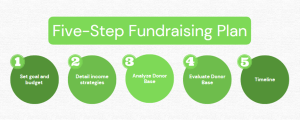Improving Organizational Systems of the Green Light Project

Sponsor: Green Light Project Maitland Garden Village
Sponsor Liaison: Ronell Trout
Student Team: DJ Brooks, Gianni Camileo, Cooper Dean, Jacob Hand
Links:
Final Presentation
Abstract:
The Green Light Project (GLP) was founded in 2011 in Maitland Garden Village, Cape Town, to strengthen community cohesion and develop the skills of community members. The goal of this project was to partner with the GLP to improve its organizational systems for sustainable operation as a nonprofit. We interviewed GLP executives and community members, analyzed documentation, and participated in GLP programs to develop a job readiness program, GLP website, and a 5-step organizational fundraising plan.
Executive Summary:
The Green Light Project, a change agent with challenges
The Green Light Project (GLP) was founded in 2011 by our sponsor Mrs. Ronell Trout to strengthen community cohesion and develop the skills of community members in Maitland Garden Village. The GLP initially established nine unique program committees, each run by community leaders and designed to promote personal and community development. Today, the GLP faces challenges with internal organization limiting its programs’ impact, sustainability, visibility, and fundraising capacity. Improving GLP organizational systems would allow the organization to achieve its mission more efficiently.
Our approach to improving GLP’s organizational systems for efficiency and sustainability
The goal of this project was to partner with the GLP to improve its organizational systems for sustainable operation as a nonprofit. To meet this goal, we identified the following three objectives:
- Improve GLP programs in order to maximize positive impact on MGV community members
- Expand the GLP’s visibility within and beyond Maitland Garden Village
- Determine ways to enhance GLP fundraising capacity through the creation of organizational tools and documents.
We began with an assessment of the current state of the GLP by observing active programs as participants, and by interviewing GLP executives and community members. We also engaged with the Garden Village Primary school to connect with the village’s children. Finally, we examined the organizational documentation, including government certificates, past program schedules, and the GLP’s constitution.
We created the Green Light Project website, to increase their visibility and improve funding opportunities. We researched content management systems and analyzed selected websites of nonprofits in the Western Cape. For content purposes, we conducted a formal timeline interview with Mrs. Trout to recount important events from GLP history and met with GLP executives to understand their preferences.
To achieve the objective of increasing fundraising capacity, we began with an initial assessment of organizational documentation, including financial records, bank statements, the GLP Constitution, and government organizational certification documents. We researched South African government regulations on organizations and obtained necessary registration documentation through the SARS website. We interviewed local NPOs to identify successful fundraising strategies and developed a sample five-step fundraising plan.
Findings and Deliverables
The project findings and deliverables are split into three sections: Programs, visibility, and fundraising to match our project objectives.
Highlighting four critical GLP programs
Through discussions with the GLP board members, we determined that the four target programs active during 2022 were: The soup kitchen, sports program, education program, and gardening program. The gardening program runs through a partnership with Great Commission Networks and table tennis through a local professional club. We also learned that GLP does not have adequate staff capacity to support the programs. Mrs. Trout was the only GLP executive member present at the GLP programs. In term of improvements, the GLP leadership wanted us to prioritize the education program, specifically the job readiness training. The purpose was to train the job seekers of Maitland Garden Village in relevant areas to their job search.
Through our evaluations and discussions with our sponsor, we suggested that the job readiness training would cover various areas of the job search as seen in Figure A.
Figure A: A flow chart detailing the categories and templates involved in the Job Readiness trainings.
Expanding GLP Visibility through the Green Light Project website
We determined that the GLP should create a website and flyers to improve their visibility. We developed the website to make the GLP visible outside Maitland Garden Village and increase donations. With this in mind, we used the key elements of website design as determined by our research and interviews with members of the Green Light Project. The website includes an option to donate directly to the GLP, a way to contact the GLP, a timeline of the GLP’s history, and active program information (Figure B).
From our research of local nonprofit websites, we found that including a link to a Facebook page is essential. Since the GLP did not have a Facebook page, we created one and linked it directly to the website’s header.
Figure B: The home page of the Green Light Project website
Strategies to Enhance GLP Fundraising Capacity
Through our review of GLP documentation, we found that the Green Light Project has been a registered nonprofit organization (NPO) since 2013. However, the organization has not yet registered with South African Revenue Services (SARS) and has never obtained a tax number. Our research has provided the documentation for a “Tax-Exemption Institution” application under the Public Benefit Organization sector. The GLP financial statements show that the organization has had three primary sources of income: Donations, a monthly stipend from the ward counselor, and fundraising events. We found that donations would not be easily accessible because the only forms of donation accepted were direct deposit into the GLP bank account or cash.
Through our interviews with local NPOs, we found that it is important for an organization to have multiple income streams. To this end we created a five-step fundraising plan for future GLP implementation using this knowledge (See Figure C and Section 4.3).
Recommendations
Based on the results and analysis above, we suggest the following, by area:
Programming
- We recommend that the GLP focuses on increasing its staff capacity to run programs effectively with more decisive leadership in each area. The GLP can more easily expand program offerings if Mrs. Trout is not the sole GLP executive responsible for leading each program. This would free her time to achieve the many other responsibilities within the organization.
- We recommend that the GLP works towards reinstating its nine original programs as staff capacity increases.
Visibility
- We recommend that the GLP designates one person to update the website at least monthly using the maintenance guide in Appendix H. It is essential to keep donors and the general public up to date with relevant information about currently running programs.
- We recommend that the Green Light Project posts consistently on its Facebook page. We found that nonprofits update the public through event pictures and schedules on social media platforms. For specific posting recommendations see Appendix H.
Fundraising
- We recommend that the GLP follows through with the Tax-Exemption application through SARS by:
- Applying for section 18A donor receipts as they will qualify for tax-deductible receipts, increasing donor appeal.
- Recruiting an auditor annually as future fundraising increases.
- We recommend that the GLP implements a five-step fundraising plan to streamline its fundraising efforts. The five-step plan is shown in Figure C.
- We recommend that the GLP applies for funding from the South African National Lotteries Commission as the organization meets the NLC’s requirements for funding. Pairing fundraising strategies with consistent government grants can enhance the GLP’s fundraising capacity.
Figure C: Five-step fundraising plan









